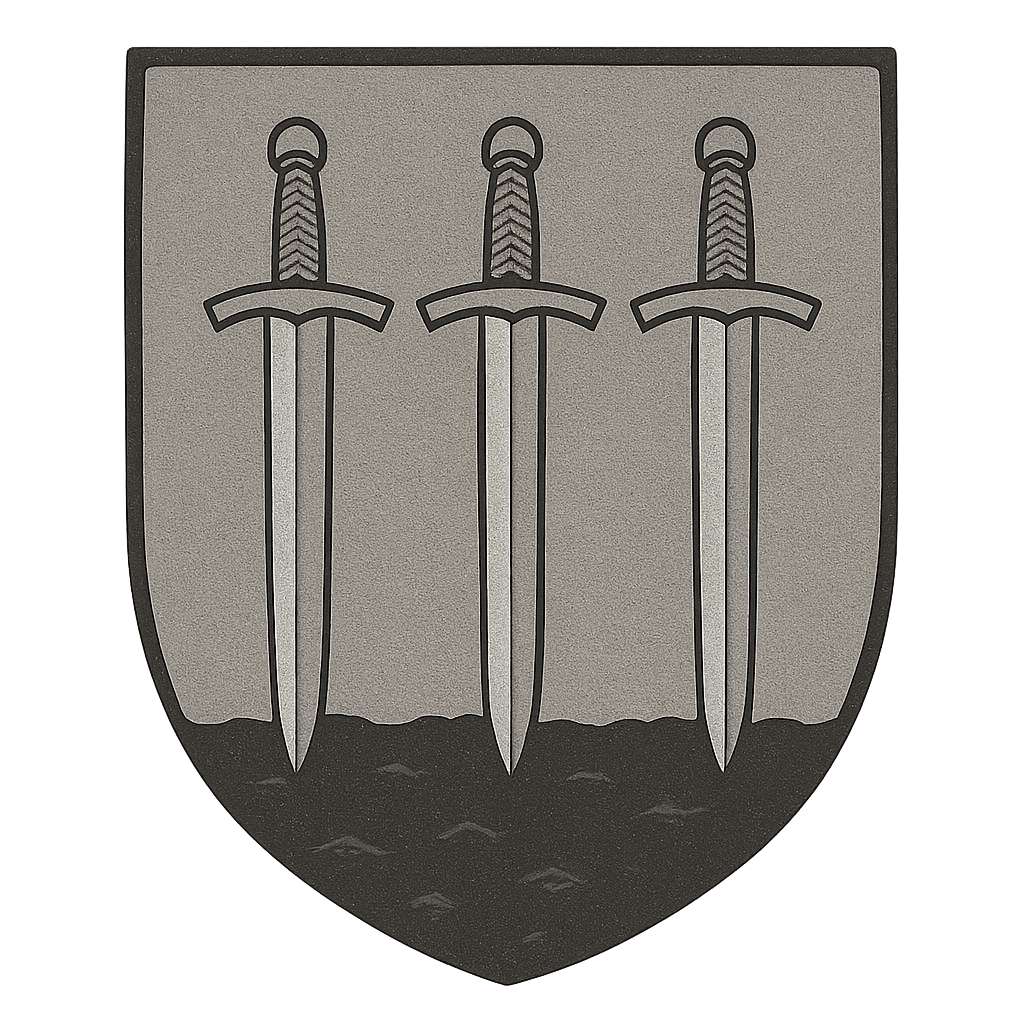Kingdom of Su
Founding Lineage: House Suvenn
Current Monarch: Sapphire Assembly
Seat of Power: Varnel
Title: Monarch of Su, Warden of the Mountain
Heraldry: A gray shield bearing three downward-pointing swords, tips sunk into dark soil
Culture
Su’s modern culture is shaped by introspection, civic reconstruction, and a deep-seated focus on rational discourse, law, and public service. Rather than erasing its tumultuous past, Su has worked to rebuild its identity as a province of duty and reform.
- Civic Identity: Most citizens of Su take pride in public contribution, be it through education, civil service, or legal interpretation. Civic pride often replaces any old noble allegiance, especially given the abolition of Su’s monarchy.
- Educational Institutions: Universities and logic schools flourish, especially in the rebuilt districts of Varnel and Tarrance. Philosophy, ethics, and civil engineering are particularly prized fields.
- Architecture & Aesthetic: Modern Suian architecture favors rectilinear order, clean lines, and structured layouts. Public plazas and courthouses dominate city centers, often built from pale stone and dark glass with preserved ruins integrated as historical reminders.
- Festivals: The Remembrance of Concord is the province’s largest public observance, commemorating the transition from monarchy to Senatorial protection.
Assets
1. The Suian Academy of Artificery and Technomantic Engineering
Founded in the early years of the Sapphire Empire but established independently by the Empire's Ministry of Science, Technology, and Innovation, the Suian Academy is the foremost institution for the study of Artificing—a newly formalized discipline that blends mechanical, scientific, and magical principles into functional designs.
Built on the former grounds of a decommissioned fortress, the Academy attracts aspiring engineers, artificers, and experimental designers from all across the Empire. It serves not just as a research facility, but also as a public-facing academic institution. The Academy has pioneered several modular constructs, arcane-filter stabilizers, and adaptive prosthetics.
Though technically within the jurisdiction of the Empire, it is staffed and attended by a majority Suian populace and functions as a major economic and cultural cornerstone for the province.
2. The Queen Ninym Memorial Gardens
Located along the quiet western edge of Varnel, the Queen Ninym Memorial Gardens were established by the people of Su to honor one of their own. Ninym, born during the chaos of the First Suian War, rose from orphanhood to become a beloved and respected leader.
The gardens are a place of reflection and civic pride. Sculptures, water paths, and etched stone walls preserve her wisdom and legacy, surrounded by native flora and curated quiet spaces. Maintained entirely by volunteers and supported by local guilds, the site is regarded as sacred by many in Su for its reminder of resilience, humility, and peace.
3. The Grand Suian Archives
Su's legal and historical archives predate even the early monarchies of Alagor. Miraculously preserved through multiple conflicts, the Grand Archives of Su are the most extensive repository of pre-unification political doctrine, land agreements, and civil codes.
Rather than being under central Imperial control, the archives are managed by a guild of Suian archivists and are open to scholars, historians, and legal specialists throughout the Empire. Though supervised to prevent ideological extremism, the archives are viewed as a national treasure and remain largely autonomous.
History
Founding and Early Rule
The Kingdom of Su was founded in the earliest years of the Alagorian unification, established by King Salvara Suvenn, one of the original Seven who approached the Four Dragons to end the tribal bloodshed ravaging the realm. Unlike his peers, Salvara was known not for his strength in arms or command of magic, but for his gift in mediation and lawmaking. It was Salvara that first proposed a autonomous kingdom-state legal code, which would go on to create the system Alagor still follows.
The kingdom quickly became a center of scholarship, codified justice, and bureaucratic excellence, with its capital city of Su evolving into a nexus of diplomacy and judicial order.
Middle Era and Political Tensions
Though prosperous, Su developed an increasingly complex relationship with magic, particularly as magical institutions across the other kingdoms grew in both visibility and autonomy. Internal factions formed—some promoting magical integration, others decrying it as a threat to reason and legal order.
This cultural schism deepened over centuries, fostering the conditions that would later be exploited by radical factions, including what would become the Cult of Atrops. Su’s judicial councils struggled to contain the ideological fragmentation of their society.
Modern Era: Collapse of the Monarchy and Imperial Oversight
The reign of King Kylok Suvenn in the late pre-Empire era marked a tragic and irreversible turning point. His collusion with the Cult of Atrops, the creation of the Amulet of Atrops, and the instigation of the Second Suian War resulted in devastating losses—both to Su and to the wider realm. The war shattered the last remnants of trust in Su’s monarchy.
Following the defeat of Kylok and the collapse of centralized governance, Su was placed under military and legal administration by Athomathia. Su’s royal line was not reinstated, instead, it was designated a Permanent Administrative Province, governed by appointed ministers under the direct authority of the Alagorian Senate and, ultimately, the Empress herself.
Military
While Su no longer maintains its own military, it does host one of the largest concentrations of Azure Vanguard outside of Athomathia:
- Imperial Garrison Varnel: Headquartered near the capital, this base houses multiple battalions of Peacekeeper forces, including anti-insurgency and civil logistics units. The garrison is considered a command node for the region, with direct uplinks to the Ministry of Defense.
- Borderwatch Stations: Scattered across Su’s frontiers with Seartor and Dravonell are a series of automated outposts and watchtowers, monitoring interkingdom movement and ensuring the containment of unrest.
- Integrated Civic Response Forces (ICRF): Su was one of the first provinces to host these dual-role civil-military teams, which are used for both law enforcement and emergency disaster response.
Trade & Transport
Despite its landlocked geography, Su remains a major trade and administrative hub within the Sapphire Empire. With its central location between multiple kingdoms and long-established infrastructure, the province facilitates considerable overland trade:
- Overland Trade Corridors: Su is crossed by two major imperial highways—Route Meridian and Spine of Su—linking it to Athomathia, Healfor, and Seartor. These roads are reinforced with armored patrol stations and logistic checkpoints operated by the Ministry of Public Welfare and Order.
- Rail & Convoy Lines: Heavy rail and hover-convoy routes, established after the Reconnection of Avalon, allow for secure and rapid movement of goods and personnel, especially toward Su and the Imperial Academy Zone.
- Administrative Logistics: Due to its central governance under Imperial supervision, Su is also home to three regional distribution nexuses that process supply routes for both civilian and military use, making it a logistical keystone.




